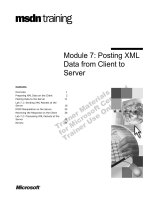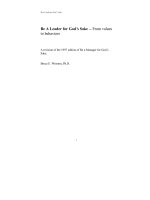From Exchange to Contributions doc
Bạn đang xem bản rút gọn của tài liệu. Xem và tải ngay bản đầy đủ của tài liệu tại đây (985.61 KB, 155 trang )
From Exchange to Contributions
From Exchange to Contributions
Generalizing Peer Production into the
Physical World
Christian Siefkes
Version 1.01b
July 2008
Edition C. Siefkes
Berlin
Copyright
c
2007–2008 by Christian Siefkes.
This work is licensed under the Creative Commons Attribution-
NonCommercial-ShareAlike 3.0 License. To view a copy of this license,
visit or send a letter to
Creative Commons, 171 Second Street, Suite 300, San Francisco, Califor-
nia, 94105, USA.
Title page drawing
c
2007 by the “History 101: A Mobile Museum” project
in the Open Architecture Network (narchitecturenetwork.
org/). Licensed under the Creative Commons Attribution 3.0 License
( />Title page photo
c
2007 by Mathias Schindler. The photo was taken
at the Wikimania 2007 Conference ( />schindler/Taiwan) and is licensed under the Creative Commons Attribution-
ShareAlike 3.0 License ( />Used with permission.
ISBN 978-3-940736-00-0
Published by EDITION C. SIEFKES,
Wilhelmshavener Str. 62, 10551 Berlin, Germany.
Printed by Lightning Source.
Website: />Contents
1 Introduction 9
2 Elements of Peer Production 13
2.1
Commons, Sharing, and Control over the Means
of Production . . . . . . . . . . . . . . . . . . . . 13
2.2 Free Cooperation . . . . . . . . . . . . . . . . . . 14
2.3 From Status to Reputation . . . . . . . . . . . . . 15
3 Problems to Solve for Generalization 17
3.1
How to Coordinate the Producer Side with the
Consumer Side? . . . . . . . . . . . . . . . . . . . 17
3.2 How to Allocate Limited Resources and Goods? 19
4 Organizing Shared Production 21
4.1 How to Find Others for Cooperation . . . . . . . 21
4.2 How to Obtain Contributions . . . . . . . . . . . 22
4.3 How to Ensure That Tasks Are Handled . . . . . 25
4.4 How to Assign Results of a Project . . . . . . . . 31
5 Fitting It All Together: A Peer Economy 41
5.1 Society as a Big Project or a Multitude of Projects 41
5.2
Sharing Effort Between Projects: Distribution Pools
42
5.3
Organizing Infrastructure and Public Services:
Local Associations . . . . . . . . . . . . . . . . . 46
5.4
Coordinating Production: Prosumer Associations
54
5.5 Resource Allocation . . . . . . . . . . . . . . . . . 62
5.6 Decision Making . . . . . . . . . . . . . . . . . . 67
5
Contents
6 Comparison with Other Modes of Production 77
6.1 Differences from a Market Economy . . . . . . . 77
6.2 Differences from a Planned Economy . . . . . . 88
7 Aspects of Life in a Peer Economy 91
7.1
Forms of Democratic Decision Making in Local
Associations . . . . . . . . . . . . . . . . . . . . . 91
7.2
Stakeholder Involvement and Conflict Resolution
95
7.3 Education and Learning . . . . . . . . . . . . . . 99
7.4
Creative Works and Other Freely Sharable Goods
101
7.5 Styles of Production . . . . . . . . . . . . . . . . 104
8 Concerns 109
8.1 How to Handle Contributions? . . . . . . . . . . 109
8.2 How to Handle Effort? . . . . . . . . . . . . . . . 117
8.3 What About Migration? . . . . . . . . . . . . . . 121
8.4
Won’t There Be Need for Further Laws and Stan-
dards? . . . . . . . . . . . . . . . . . . . . . . . . 124
8.5
Won’t Such a Society Revert to a Market Economy?
126
8.6
Aren’t There Many Variants to the Proposed
Model? . . . . . . . . . . . . . . . . . . . . . . . . 128
9 Conclusion: The Development of a Peer Economy 131
Bibliography 137
A Mathematical Details of the Auctioning Models 143
A.1 Task Auctioning . . . . . . . . . . . . . . . . . . . 143
A.2 Product Auctioning . . . . . . . . . . . . . . . . . 146
A.3 Resource Auctioning . . . . . . . . . . . . . . . . 149
A.4 Virtual Effort . . . . . . . . . . . . . . . . . . . . . 150
6
The world that we must seek is a world in which
the creative spirit is alive, in which life is an
adventure full of joy and hope, based rather upon
the impulse to construct than upon the desire to
retain what we possess or to seize what is
possessed by others. It must be a world in which
affection has free play, in which love is purged of
the instinct for domination, in which cruelty and
envy have been dispelled by happiness and the
unfettered development of all the instincts that
build up life and fill it with mental delights. Such a
world is possible; it waits only for [wo]men to
wish to create it.
Bertrand Russell, Roads To Freedom
1 Introduction
A new mode of production has emerged in the areas of
software and content production during the last decades.
This mode, which is based on sharing and cooperation, has
spawned whole mature operating systems such as GNU/Linux
and various BSD systems as well as innumerable other free
software applications, some of which form the backbones of
the Internet or the core of various enterprises; giant knowledge
bases such as the Wikipedia; a large free culture movement
often based on Creative Commons licenses; and a new, wholly
decentralized medium for spreading, analyzing and discussing
news and knowledge, the so-called blogosphere; among oth-
ers.
Yochai Benkler has coined the term
peer production
to de-
scribe this collaborative and open mode of production which
has become typical for the Internet in recent years (Benkler,
2002; 2006). Benkler makes it clear that
peer production
(or its
generalization,
social production
) is a third mode of production
that is fundamentally different from both
market
-based pro-
duction and
firm
production. Market systems are based on
equivalent exchange
(with or sometimes without money), while
firms (and also the former “socialist” planned economies such
as the Soviet Union) rely on hierarchies and organized plan-
ning to distribute tasks and resources.
Peer production, on the other hand, is based on
contributions.
People contribute to a project because they want it to succeed,
not because they need to earn money or have to realize some
previously established plan. Some peer projects
require
contri-
9
1 Introduction
butions (peer-to-peer distribution networks such as BitTorrent
require downloaders to upload), while others are open even to
non-contributors (you do not have to write any free software
to be allowed to use it). Often projects are partially, but not
completely open; large free software and open content projects
usually allow only active participants to take part in decision
making processes, but everyone is allowed to access, distribute,
and modify the produced information.
While Benkler has identified social production and peer pro-
duction as important phenomena, he appears to consider them
relevant only for certain niches of production, such as informa-
tion goods. In this text we will discuss whether this limitation
to niches—even important niches such as information goods—
is justified or whether it under-estimates the potential of peer
production. To put it in other words: Is a society possible in
which peer production is the
primary
mode of production? If
so, how could such a society be organized?
In the next two chapters, we will discuss several important
characteristics of peer production and introduce the major
problems that need to be addressed for generalizing peer
production beyond the sphere of information. In Chapter 4 we
will investigate how these problems can be addressed within
the context of individual peer projects, finding that there are
indeed suitable solutions. In Chapter 5 we will turn from
the internal organization of peer projects to the “big picture,”
discussing how a multitude of such projects might fit together
in a society where peer production is the primary mode of
production.
Finding that such a society is feasible, we will in Chapter 6
compare it with societies based on market production and on
planned production, the two economic modes that have been
dominant during the last centuries. We will show that there are
striking differences to both of them, and that a society based on
10
peer production would grant people an unprecedented amount
of control over their own lives, while avoiding the overhead,
arbitrariness, or unfairness characteristic of other modes of
production. Prior to concluding the text, we will examine how
the people living in such a society might organize various
aspects of their lives (Chap. 7), and we will address several
concerns that might be brought forward in regard to such a
peer economy (Chap. 8).
11
2 Elements of Peer Production
We will start our investigations by briefly treating some char-
acteristic elements of the peer mode of production.
To prevent confusion about our use of the term
production
we would like to point out that we will use this term in a
broad sense that can include any activities related to creating
or doing something that is of use to anybody.
Production
in
this sense comprises not just the design and manufacturing of
new things, but also repair and maintenance, services of any
kind, domestic work, etc.
Benkler differentiates between
peer production
and
social pro-
duction,
regarding the former as a subset of the latter. We
will not follow this distinction and use both terms largely
synonymously.
2.1 Commons, Sharing, and Control over the Means of
Production
Benkler uses the term
commons-based
peer production to de-
scribe the kind of peer production that has emerged on the
Internet (free software, centralized or decentralized open con-
tent projects such as the Wikipedia and the blogosphere, dis-
tributed computing projects such as SETI@home, etc.).
Com-
mons
are resources without owners who can control how they
can be used; resources that are available to all who want to
use them. The output of such peer projects generally becomes
part of the commons, being freely available to everybody (or,
at least, to everybody involved in the project).
13
2 Elements of Peer Production
In current peer projects, the resources required for these
projects (“means of production” such as computing power
and Internet access) are usually privately owned but readily
available to all participants. Peer production thus fulfills the
old Marxist postulate that
control over the means of production
should be in the hands of the producers
: the means of production
are available either as commons (peer projects can build upon
the code and content produced by other projects) or as some
kind of
pseudo-commons
(resources that are readily available to
those who use them).
Information can be copied at almost zero cost, thus, being
shared, it is still as available to the sharer as before. Some
peer projects also involve the sharing of other resources which
lack this property, but they do so in a pragmatic way which
does not place a serious burden on the sharer. People partici-
pating in a wireless community network share their spurious
networking capacity; the participants of shared computation
projects such as SETI@home
1
donate computing power they
don’t need for any other purposes. This sharing philosophy
might be expressed as “Share what you can”—sharing is com-
monplace, but nobody expects other people to give to others
what they need for themselves. As Richard Stallman (2002,
p. 46) puts it: “When I cook spaghetti, I do object if someone
else eats it, because then I cannot eat it.”
2.2 Free Cooperation
Cooperation
is essential for many human activities—for all ac-
tivities that cannot or are not handled by a single person. In
a corporate or state context, cooperation usually contains an
1
/>14
2.3 From Status to Reputation
element of coercion—there is somebody who can tell you what
to do, and then you should better do it, or else. . . .
In peer production, this moment of coercion is notably ab-
sent. Nobody can
order
others to do something, and nobody
is forced to obey others. This does not mean that there are no
structures—on the contrary, usually there are maintainers or
admins or some other persons who can decide, for example,
which contributions to accept and which to refuse. But nobody
can compel others to do anything they do not want to do.
Moreover, all members of a project participate because of
their own choice. You don’t
have
to participate in a project,
and there are no sanctions when you leave it.
Goals and internal organization of a project depend on the
participants and will generally evolve along with a project. If
some of the participants of a project are unhappy about some
aspects of the project and cannot convince the others to change
them, they can still
fork
the project: they can break away from
the others and do their own thing.
Obviously, these traits of cooperation in a peer context can-
not override the rules of the corporate world. In many large
free software projects some of the development work is paid
for by companies. For such paid developers, the normal rules
of firms continue to apply—employees must obey their su-
periors, freelancers are bound to the contract they agreed to.
But those who participate in a peer project without being paid
for it, cooperate freely and are not subjected to anybody’s
command.
2.3 From Status to Reputation
In market economies (and also in planned economies such as
the former Soviet Union), the
social position
and
social status
of
a person tend to be important both as driving forces (people
15
2 Elements of Peer Production
strive to increase their status) and as factors for judging others.
In peer projects,
reputation
plays a similar role (cf. Lehmann,
2004).
Formal criteria such as job title or academic degree tend
to be of little interest for peer projects; inborn characteristics,
such as gender, “race,” or age, are often not even known.
Instead, people are judged by their contributions, and both
the quality of contributions (developers writing good code)
and the initiative of contributors (founding a new successful
project) tend to increase a person’s reputation.
Reputation is often more volatile than social status; it will
suffer more quickly if people start misbehaving or making
dubious or awkward contributions instead of helpful ones
(this seems to have happened to Eric Raymond, a former star
of the open source movement, at least to a certain degree).
Project maintainers are expected to “do the right thing;” if
the members of a project feel their decisions to be unfair or
incompetent, they will sooner or later leave the project or start
looking for a new maintainer.
Complementary to the decreased significance of social sta-
tus, “status symbols,” objects meant to imply a high social
status of their owner, seem to lose importance. This is not
surprising, since such symbols, which in a market economy
usually indicate material wealth, can hardly indicate a per-
son’s
reputation.
Also, as stated above, peer production is
largely centered around the concepts of
commons,
resources
that are available to all; and where things are readily available
for anyone who wants them, status symbols become rather
pointless.
16
3 Problems to Solve for Generalization
After having quickly covered some of the traits we can observe
for the current practice of peer production in the areas of
software and content production, we will now turn to the
problems that so far have limited the scope of this mode of
production. There appear to be two fundamental problems
that would need to be solved to generalize peer production
into further areas of the physical world, beyond information
production:
1.
How to coordinate the producer side (“fun and passion”)
of peer production with the consumer side (“needs and
desires”)?
2. How to allocate limited resources and goods?
We will discuss each of these problems in turn.
3.1 How to Coordinate the Producer Side with the
Consumer Side?
In any system of production and social organization, two
roles of people can be distinguished:
producers
who create
or provide goods (including services), and
consumers
who
consume or use them. These two roles are not necessarily
separate—people can be both producers and consumers at the
same time (“prosumers”), but neither can they be expected to
always fall together. Especially in regard to public services
such as education, health care, and elder care, it is evident that
the “consumers” of such services
cannot
generally be the same
people that provide them.
17
3 Problems to Solve for Generalization
Peer production, as we know it today, is mainly
producer-
driven
: it relies on the choices and motivations of people acting
as producers in what they want to produce. In many cases,
these producers are also consumers (free software developers
contribute to software they need or want to use), but people
who
cannot
create what they want to use are generally out of
luck; they cannot do much more than hope that somebody
will pick up their needs.
This also affects the output of peer production processes—
most free software programs, for example, are still far less
user-friendly for the general public than proprietary programs;
exceptions, such as the major Linux distributions, the Firefox
browser and the Thunderbird e-mail client, or the OpenOffice
suite, usually involve commercial players—they are partially
driven by market forces, not pure examples of peer production.
Peer producers act out of fun, passion, and the desire to do
something useful and to “give something back” to the com-
munity, as analyzed by Linus Torvalds and Pekka Himanen
(Himanen, 2001) and by Lakhani and Wolf (2005), among oth-
ers. They do what they do because they like doing it, because
they love solving interesting problems, being creative, and cre-
ating something useful. Prosumers “scratch an itch,” solving
problems they wish to be solved in a way that is useful to
others as well as to them, since in this way they are likely to
get better results, by inciting others to contribute as well.
Such motivations will certainly remain fundamental driving
forces, but peer production will hardly become the dominant
mode of production unless there is a way to synchronize it with
the other side of people—with people as users or consumers,
people who have
needs
which they like to have satisfied even if
they lack the knowledge or faculties to satisfy them themselves.
18
3.2 How to Allocate Limited Resources and Goods?
3.2 How to Allocate Limited Resources and Goods?
The second issue that needs to be addressed concerns the
allocation and distribution of resources and goods that cannot
be made available in sufficient amount to satisfy all needs. For
information goods, this is not an issue, since (aside from legal
obstacles) they can be copied as often as wished at practically
zero cost. Material goods, however, are very different in this
regard.
Personal fabricators,
or
fabbers
(Gershenfeld, 2005), are an
emergent technology that promises to make (at least some)
material goods as easily and cheaply copyable as information
goods. But while we can expect this technology to alleviate
the problem of producing material goods at some point in the
future, it will never fully solve it.
If peer production were only a viable option for
copyable
goods, generalizing it into the physical world would not be
possible until fabbers have become sufficiently advanced. This
might be the case in a few decades, or a few centuries, or
maybe never. Even then, fabbers will need some resources
to work, they will need to be produced and maintained, and
they will hardly be able to produce
everything.
Hence, fabbers
are unlikely to ever solve the problem of material production
completely.
But let’s assume that, at some point in the future, fabbers
will be able to produce everything (including “big stuff” such
as houses) without needing resources that are not already
freely available to everyone. Even then, fabbers would not
be able to solve all problems regarding material production
and allocation. There are properties that cannot be copied,
such as
location.
Even if fabbing were able to provide attractive
apartments and houses for anyone who wants them, dwellings
19
3 Problems to Solve for Generalization
with sea view would remain a limited good, especially those
that are near an attractive city center.
Rivalness
is another problem regarding allocation that fab-
bers cannot solve—if everybody has their own car, nobody
will get very far in it, because of all those jams. Then there are
issues such as environmental damages caused by too many
people using the same products. Clearly, while fabbing is an
interesting technology that deserves attention, it will never be-
come a “deus ex machina” able to solve all relevant problems.
20
4 Organizing Shared Production
Fabbing would allow an individual mode of production, where
everybody would be able to produce what they need on their
own, without the help of others. Without such an “autonomy”
technology, people either have to rely on the market to buy
what they need (assuming they can afford it), or else they
need to cooperate with others, to jointly produce what they
want to have, and to share and divide the results of this
shared
production
process in a way that is acceptable to everyone
involved.
People involved in shared production need to address sev-
eral issues, which we will discuss in turn: they need to find
others that are willing to cooperate; they need to find ways
of obtaining sufficient contributions and ensuring that all re-
quired tasks are handled; and they have to find ways of as-
signing the produced results that are acceptable to everyone
involved. In this chapter, we will regard these problems from
the perspective of a single project; how to generalize the found
solutions beyond this context will be discussed in the next
chapter.
4.1 How to Find Others for Cooperation
There are two ways in which people tend to find other people
for this process of cooperation: by common interest, or by
location.
Finding others
by common interest
is the typical way in which
the current Internet-based peer production processes tend
21
4 Organizing Shared Production
to organize themselves: people contribute to free software
programs they like or need; they write for the Wikipedia or
other suitable forums about their topics of interest; they create
and remix free music or other kinds of free culture in the styles
and of the kinds they care about.
The alternative is finding others
by location,
i.e., cooperat-
ing with people in your neighborhood. This style of shared
production is very old—it has probably been an element in
the evolvement of social structures up from ancient times (cf.
Sahlins, 1974, esp. pp. 74–95, 185–230).
The two alternatives do not exclude each other. There are
peer projects where both interest and location matter, for exam-
ple, book-sharing communities such as the Distributed Library
Project
1
.
In a society where shared production is the primary mode of
production, we can expect both modes of finding others to be
employed. There are things that concern all the people living
in a specific area, such as the providing and maintenance of
infrastructure, hence we may assume that everybody would
be a member of a
local community
or some other kind of
local
association
organizing these issues. And people with specific
interests would continue to search others with similar interests
and cooperate with them in the context of
peer projects,
just as
they do now.
4.2 How to Obtain Contributions
As mentioned above, shared production is a very old mode
of production; it has already figured in the lives of hunter-
gatherer societies thousands of years ago. Since then, however,
1
/>22
4.2 How to Obtain Contributions
work has become more and more complex. Division of labor
might not have been much of an issue in ancient societies, but
it is essential for modern society.
In hunter-gatherer-style societies, what little specialization
there was was usually assigned by
tradition
—tasks were dis-
tributed based on criteria such as gender (men were assumed
to be hunters, women had to gather edible plants and to care
for the children) or inheritance (the oldest son or child of
a chief or shaman would become his successor). Obviously,
such a tradition-based assigning of tasks would be unaccept-
able by modern standards; moreover, it would be completely
insufficient to handle the complex division of labor we see
today.
So how can peer projects and communities organize the
internal division of labor; how can they ensure that all tasks
are picked up?
Current peer projects usually rely on
voluntarism:
contrib-
utors choose a task or tasks they want to do among all open
tasks (e.g., writing a new feature, fixing a bug, writing doc-
umentation, or testing, in case of a free software project);
everybody contributes voluntarily as much (or as little) effort
as they want.
Voluntarism is very reasonable for the production of certain
goods, especially those that can be duplicated at near-zero
cost, such as information goods—it would not make sense for
the Wikipedia to exclude non-editors from reading articles.
However, it is unclear how it should apply to the production
of material goods where the production of additional units
does cause additional non-trivial costs. A peer project aimed
at producing cars (not just the design, but actual running
vehicles) will hardly be able to hand over a car to everyone
who wants one, whether they contribute anything or not—
23
4 Organizing Shared Production
even if the contributing members of the project were willing
to do so, they would lack the necessary resources, so they will
have to ask for some contribution in return.
Similarly, while
local communities
based entirely on volun-
tarism might be possible, it is hard to imagine that they would
be stable. The organization of a community is very complex
and involves a lot of tasks, not all of which are nice to do.
There are tasks such as garbage removal which will proba-
bly be disagreeable to most people and are unlikely to draw
sufficient volunteers.
Without volunteers, a community would fall into disarray;
but even if some people volunteer for such disagreeable tasks,
they would probably do so out of a sense of responsibility for
the community, not because they like the task. This would
lead to the risk of increased psychological strain within the
community—the volunteers for the unpleasant jobs would
most likely resent those who perform only agreeable tasks (or
no tasks at all) and get away with it.
Peer projects and communities will therefore have to decide
whether or not they
require
contributions from those who want
to benefit from the cooperation (at least in regard to
material
benefits—information, as stated before, can be shared freely
since sharing it does not cause additional cost). A simple
way to do this would be to ask all participants to contribute
a certain amount of hours (per month or some other suitable
unit) to the project, letting contributors choose which tasks
they want to handle. While such a
flat labor
approach might be
suitable for some projects, it fails to address the observation
made above: while people have widely different preferences
about what they do and do not like, there are some tasks
that nobody or almost nobody likes to do, because they are
annoying, dirty, dangerous, or just plain boring.
If a project wants to be successful, it needs a way to cope
24
4.3 How to Ensure That Tasks Are Handled
with such tasks, and generally to take people’s preferences
into account. In the next section we will discuss ways of doing
this.
4.3 How to Ensure That Tasks Are Handled
There appear to be at least three strategies peer projects can
use in regard to unpleasant tasks:
1. Automate them away;
2.
Make them more fun (more agreeable, more interesting,
safer, easier);
3. Make them shorter (by weighting them higher).
We suppose that all of these strategies would be employed
in a society that relies primarily on peer production.
4.3.1 Automation
The power of automation has already shown amazing results
during the last centuries. Various professions such as typeset-
ters have become obsolete through the use of computers; in
1900, 38% of the U.S. labor force were occupied with farming;
in 2000, this fraction had fallen below 3% (National Academy
of Engineering, 2007); modern factories require only a small
fraction of the labor of 18th century manufactories to produce
items whose complexity would have been inconceivable even
50 years ago. There is little reason to assume that the possi-
bilities of automation are already near a climax—more likely,
it will continue to increase in the future, further reducing the
amount of human work necessary to handle many tasks.
But in market-based systems, automation cannot reach its
full potential especially in regard to unpleasant tasks. In mar-
ket production, automation needs to be cost-efficient to be
successful: the costs of introducing and using an automation
25









